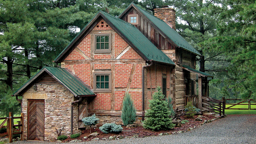Establishing an accurate cost is one of the challenges of purchasing any log home that has yet to be built. The reason for this is simple: it's impossible to know the true cost of construction until construction is completed.

As you may already be aware, this situation leads to a certain amount of anxiety on the part of log home enthusiasts. Adding to the anxiety is the fact that many log home purchasers plan to be involved in constructing their home, either as general contractors or builders. This places them squarely in the driver's seat when it comes to pricing their project. It's common to hear someone extolling the virtues of owner-contracting and all its possible savings. It's rarely pointed out, however, that owner-contractors and self-builders can lose a significant amount of money, even paying more for their home than if they had it built by professionals. How does this happen, and what can be done to prevent it? The key to controlling costs in a log home project starts with an accurate budget. This means preparing a detailed cost estimate with accurate bids and approximations. When I was building homes, I occasionally encountered log home do-it-yourselfers who had gotten into a predicament simply because they never bothered to prepare an accurate cost estimate. Going into a project without such an estimate usually sets the stage for some unpleasant surprises. Does this mean that a detailed cost estimate is guaranteed protection against financial surprises down the road? Unfortunately, no. Many cost overruns are nothing more than something that was overlooked when preparing the estimate.
Subcontractors
To ensure an accurate cost estimate, insist on written bids and detailed estimates from subcontractors and suppliers. Insist on bids by the job, rather than as unit quantities such as square footage. Also rely only on figures from the people who will be providing the material or doing the work. Second-guessing subcontractors can lead to costly surprises. Sometimes, home owners rely on unit estimates such as cost per square foot for specific work. This method only works when you know how the subcontractor is calculating square footage. Each trade has its own set of estimating rules. Unless you know the conventions used in a particular trade, insist that the subcontractors provide a project estimate. Be forewarned that subcontractors usually require current blueprints to prepare project bids. Another setup for trouble occurs when an owner-builder obtains a figure from one subcontractor and then contracts with another without obtaining a cost from them, assuming that the unknown cost will be close to the figure they've already obtained. The range spanned by bids and estimates for the same work can be amazing. The most reliable figures come from the subcontractors and suppliers who will be providing the services and materials.
Construction
Specifications, itemized materials and construction methods can cause many cost overruns. If you are using a general contractor, he should ask you specific questions about the light fixtures, cabinetry and other project details. When contractors or subcontractors are asked to price material or labor for which they have received no instructions, one of two things usually happens--they price using "builder-grade" materials, or they price with minimum acceptable construction standards. This often isn't pointed out anywhere in their contract. Your first clue comes when an item that is well below the quality you expect shows up at your site. Changes during construction can account for serious cost overruns. Subcontractors provide bids to perform specific work using specific materials, and changing either the materials or the way those materials are to be used changes the price. When you request a change, many subcontractors automatically will present you with a change order showing the additional cost. It is standard practice for subcontractors to require payment at the time of the change order (before performing the actual work), because they know that such work usually is not covered in the construction loan.
Allowance
The selection of light fixtures usually takes place well after bids have been submitted and often after actual construction has started. In order to make sure the fixtures are included in overall cost estimates or contracts, the contractor or owner-builder includes an estimate called an "allowance." This means that the allowed amount is included in the contract and that anything over that amount is an extra charge. To avoid such cost overruns, carefully review all allowance amounts. These may include cabinetry, appliances, light and plumbing fixtures, septic systems, wells and floor and ceiling coverings. Make sure allowances are realistic by pricing items that are at least of comparable quality. Don't rely on the subcontractor to read your mind for your taste in cabinetry. Visit a cabinet shop or supplier, and pick something that is in the appropriate price range. Obtain an estimate from the supplier based on your kitchen plan. If necessary, have your contractor adjust his allowance or note that you anticipate additional expenses when it comes time to purchase cabinets. Clearing, excavating, road building and other site work often are handled like allowance items although you may actually have firm bids. This happens because almost all site work-related contracts include clauses protecting the subcontractor in the event that they encounter unexpected ground conditions. Well drillers cannot reliably predict that they will reach safe drinking water by a specific depth, so even when providing a firm bid, their contract usually includes a protective clause in case they have to dig deeper. Excavators also have protective clauses in their agreements to guard against encountering unexpected rock or water. This kind of situation almost always results in extra charges. To minimize the risk of cost overruns resulting from site conditions, use excavators and subcontractors who are familiar with local conditions. Also, interview neighbors for their own experiences. Replacing subcontractors during construction often carries a hefty price tag. Rarely will a subcontractor honor a previous bid if another subcontractor has already begun the work. Since the incoming subcontractor ultimately must build on work done outside his control, he will usually charge to cover the added liability. As an owner-builder, you should ensure that everyone is informed of the status of construction and materials are always on site when the subcontractor arrives. In addition to the cost of the delay, costs may be added for having to reschedule or replace other subcontractors whose schedule is affected by the change. The potential sources for cost overruns may seem intimidating, especially to someone who hasn't worked with home construction projects. Following a few basic rules, however, can greatly reduce the possibilities of most of these hazards.
- Pick your subcontractors carefully. Look at their workmanship and check their references.
- Specify on paper as completely as possible the materials and construction methods you want in your home.
- Make sure allowances are realistic.
- Talk to the neighbors about what you might expect in drilling wells, building roads, installing septic systems or digging foundations.
- Always demand written change orders before allowing changes or authorizing additional work.
- Make sure subcontractors have proper tools when they arrive at the site.
None of these rules requires special knowledge or training. Yet these simple rules can save you frustration and thousands of dollars in unexpected costs.
 As you may already be aware, this situation leads to a certain amount of anxiety on the part of log home enthusiasts. Adding to the anxiety is the fact that many log home purchasers plan to be involved in constructing their home, either as general contractors or builders. This places them squarely in the driver's seat when it comes to pricing their project. It's common to hear someone extolling the virtues of owner-contracting and all its possible savings. It's rarely pointed out, however, that owner-contractors and self-builders can lose a significant amount of money, even paying more for their home than if they had it built by professionals. How does this happen, and what can be done to prevent it? The key to controlling costs in a log home project starts with an accurate budget. This means preparing a detailed cost estimate with accurate bids and approximations. When I was building homes, I occasionally encountered log home do-it-yourselfers who had gotten into a predicament simply because they never bothered to prepare an accurate cost estimate. Going into a project without such an estimate usually sets the stage for some unpleasant surprises. Does this mean that a detailed cost estimate is guaranteed protection against financial surprises down the road? Unfortunately, no. Many cost overruns are nothing more than something that was overlooked when preparing the estimate.
As you may already be aware, this situation leads to a certain amount of anxiety on the part of log home enthusiasts. Adding to the anxiety is the fact that many log home purchasers plan to be involved in constructing their home, either as general contractors or builders. This places them squarely in the driver's seat when it comes to pricing their project. It's common to hear someone extolling the virtues of owner-contracting and all its possible savings. It's rarely pointed out, however, that owner-contractors and self-builders can lose a significant amount of money, even paying more for their home than if they had it built by professionals. How does this happen, and what can be done to prevent it? The key to controlling costs in a log home project starts with an accurate budget. This means preparing a detailed cost estimate with accurate bids and approximations. When I was building homes, I occasionally encountered log home do-it-yourselfers who had gotten into a predicament simply because they never bothered to prepare an accurate cost estimate. Going into a project without such an estimate usually sets the stage for some unpleasant surprises. Does this mean that a detailed cost estimate is guaranteed protection against financial surprises down the road? Unfortunately, no. Many cost overruns are nothing more than something that was overlooked when preparing the estimate.











